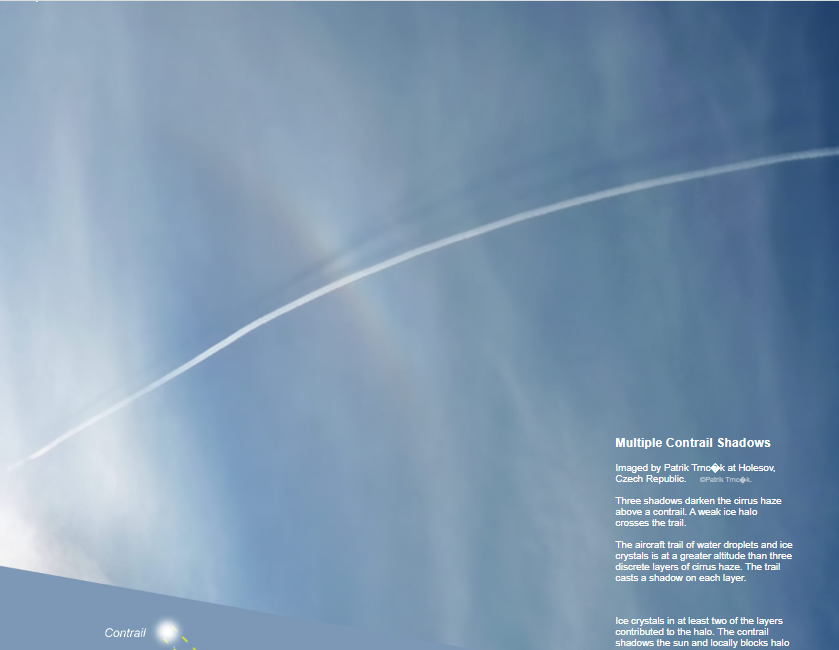OPOD - Halo & Contrail Shadows
OPOD - Halo & Contrail Shadows: A Fascinating Atmospheric Phenomenon Explored
Have you ever gazed up at the sky and been captivated by the intricate interplay of light and shadow? Atmospheric optics is a field that unravels the secrets behind these mesmerizing displays. In this article, we delve into the phenomenon of halo and contrail shadows, shedding light on their formation and captivating beauty.
Contrail Shadows: A Trio of Shadows in the Cirrus Haze
Imagine looking up and noticing three distinct shadows casting a darkened veil over a layer of cirrus haze. This intriguing spectacle was captured by Patrik Trnc�k at Holesov, Czech Republic. What causes these contrail shadows? Let's explore further.
The shadows are formed due to the presence of an aircraft trail composed of water droplets and ice crystals, which is positioned at a higher altitude than the three layers of cirrus haze. As the trail passes through each layer, it casts a shadow, creating a visually striking effect.
The Role of Ice Crystals in Halo Formation
Upon closer inspection, one can observe a faint ice halo intersecting the contrail. This halo is a result of ice crystals present in at least two of the cirrus haze layers. These tiny ice particles interact with sunlight, bending and refracting its rays to create the ethereal halo effect. However, the presence of the contrail shadows inhibits the formation of the halo in certain areas, as it blocks the sun's rays locally.
Unraveling the Complexity of Halo Formation
The formation of halos is a complex process influenced by various factors. Here are some key points to consider:
- Ice crystals in the atmosphere act as prisms, bending and splitting sunlight to create colorful halos.
- The shape and orientation of ice crystals determine the type of halo observed.
- Halos can be circular, elliptical, or even appear as arcs or spots.
- The size and concentration of ice crystals also play a role in the intensity and visibility of halos.
Contrail Shadows: A Temporary Disturbance in Halo Formation
Contrail shadows provide a fascinating twist to the halo formation process. While halos are typically formed by ice crystals in the cirrus haze, the presence of contrail shadows can disrupt this natural occurrence. These shadows block the sunlight that would otherwise interact with the ice crystals, resulting in localized areas where halos cannot form.
The Beauty of Atmospheric Optics
Atmospheric optics continually astounds us with its breathtaking displays of light and shadow. The interplay between contrail shadows and halo formation exemplifies the intricate nature of these phenomena. By observing and studying such occurrences, we gain a deeper understanding of the complexities that shape our atmospheric environment.
Capturing the Magic: Photography and Atmospheric Optics
Photography provides a means to capture and share the beauty of atmospheric optics with the world. Patrik Trnc�k's stunning photograph of the contrail shadows and halo serves as a testament to the awe-inspiring sights that can be witnessed in our skies. Through the lens of a camera, we can freeze these transient moments and preserve them for future generations to appreciate.
Further Exploration: Diving Deeper into Atmospheric Optics
The study of atmospheric optics offers endless opportunities for exploration and discovery. Scientists and enthusiasts alike continue to investigate the intricacies of light, shadow, and the ever-changing atmosphere. By delving deeper into this field, we can uncover new insights into the workings of our planet's atmosphere and gain a deeper appreciation for the wonders that unfold above us.
Conclusion
The phenomenon of halo and contrail shadows brings forth a captivating interplay between light, ice crystals, and atmospheric conditions. The trio of contrail shadows cast upon cirrus haze, coupled with the formation of an ice halo, presents a mesmerizing sight to behold. Through photography and scientific inquiry, we continue to unravel the complexities behind these atmospheric optics phenomena, adding to our collective understanding of the world above. So, next time you find yourself gazing at the sky, take a moment to appreciate the enchanting beauty that lies within the interplay of light and shadow.

Multiple Contrail Shadows
Imaged by Patrik Trnc�k at Holesov, Czech Republic. ©Patrik Trnc�k.
Three shadows darken the cirrus haze above a contrail. A weak ice halo crosses the trail.
The aircraft trail of water droplets and ice crystals is at a greater altitude than three discrete layers of cirrus haze. The trail casts a shadow on each layer.
Ice crystals in at least two of the layers contributed to the halo. The contrail shadows the sun and locally blocks halo formation.

Note: this article has been automatically converted from the old site and may not appear as intended. You can find the original article here.
Reference Atmospheric Optics
If you use any of the definitions, information, or data presented on Atmospheric Optics, please copy the link or reference below to properly credit us as the reference source. Thank you!
-
<a href="https://atoptics.co.uk/blog/opod-halo-contrail-shadows/">OPOD - Halo & Contrail Shadows</a>
-
"OPOD - Halo & Contrail Shadows". Atmospheric Optics. Accessed on November 26, 2024. https://atoptics.co.uk/blog/opod-halo-contrail-shadows/.
-
"OPOD - Halo & Contrail Shadows". Atmospheric Optics, https://atoptics.co.uk/blog/opod-halo-contrail-shadows/. Accessed 26 November, 2024
-
OPOD - Halo & Contrail Shadows. Atmospheric Optics. Retrieved from https://atoptics.co.uk/blog/opod-halo-contrail-shadows/.